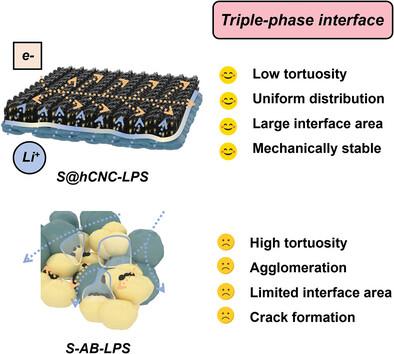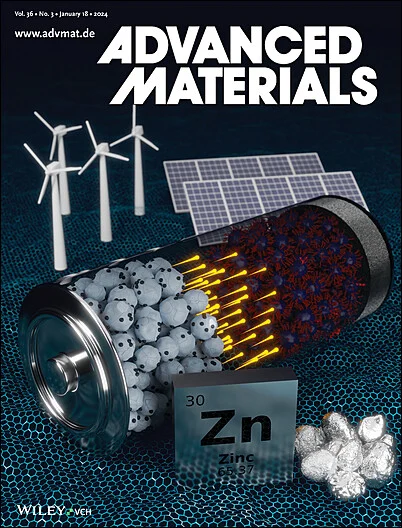利用分层碳纳米笼为高实际容量全固态锂离子电池设计三相界面
IF 27.4
1区 材料科学
Q1 CHEMISTRY, MULTIDISCIPLINARY
引用次数: 0
摘要
全固态锂硫电池(ASSLSBs)因其能量密度高、安全性强等优点而受到广泛关注。然而,由固态电解质(SE)、离散导电炭黑和微量硫(μ-S)组成的典型复合结构具有长程锂+/e-传导路径和巨大的体积变化,因此存在电荷传输迟缓和严重的电化学-机械故障。在这项工作中,采用了一种独特的分层碳纳米笼(hCNC)作为连续导电网络,并在其中限制了纳米硫。由于多维(颗粒、界面和电极)结构工程的协同效应,这种新型硫碳复合阴极(S@hCNC39)可以实现硫和碳的均匀分布,并有效地构建三相界面,从而增强了电荷载体的传输,提高了电化学-机械稳定性。使用 S@hCNC39 组装的 ASSLSB 在 30 °C、0.2 C 条件下循环 300 次后,循环性能达到 89%。值得注意的是,在硫含量高达 40% 和硫负荷高达 6 mg cm-2 的情况下,ASSLSB 在 60 °C 下稳定循环时实现了 9.95 mAh cm-2 的超高等面积容量。这些结果为设计合理的硫-碳复合材料提供了重要的启示,并为提高 ASSLSB 的整体性能提供了可行的方法。本文章由计算机程序翻译,如有差异,请以英文原文为准。

Engineering Triple-Phase Interfaces with Hierarchical Carbon Nanocages for High-Areal-Capacity All-Solid-State Li-S Batteries
All-solid-state lithium-sulfur batteries (ASSLSBs) have garnered widespread attention due to their advantages of high energy density and enhanced safety. However, the typical composite structure composed of solid-state electrolyte (SE), discrete conducting carbon black, and microsized sulfur (μ-S) with long-range Li+/e− conducting path and huge volume changes, suffers from sluggish charge transport and severe electrochemical-mechanical failure. In this work, a unique hierarchical carbon nanocage (hCNC) is applied as a continuous conducting network where nanosized sulfur are confined. Due to the synergistic effects of multi-dimensional (particle, interface, and electrode) structural engineering, this new sulfur-carbon composite cathode (S@hCNC39) can achieve uniform distribution of sulfur and carbon, and efficiently constructs triple-phase interfaces, showing enhanced charge-carrier transport and improved electrochemical-mechanical stability. Remarkable cycling performance of 89% after 300 cycles at 0.2 C at 30 °C is realized in ASSLSBs assembled with S@hCNC39. Notably, ASSLSBs achieve an ultrahigh areal capacity of 9.95 mAh cm−2 with stable cycling at 60 °C with high sulfur contents of 40% and high sulfur loadings of 6 mg cm−2. These results provide critical insights into the design of rational sulfur-carbon composites and offer a viable approach to enhance the overall performance of ASSLSBs.
求助全文
通过发布文献求助,成功后即可免费获取论文全文。
去求助
来源期刊

Advanced Materials
工程技术-材料科学:综合
CiteScore
43.00
自引率
4.10%
发文量
2182
审稿时长
2 months
期刊介绍:
Advanced Materials, one of the world's most prestigious journals and the foundation of the Advanced portfolio, is the home of choice for best-in-class materials science for more than 30 years. Following this fast-growing and interdisciplinary field, we are considering and publishing the most important discoveries on any and all materials from materials scientists, chemists, physicists, engineers as well as health and life scientists and bringing you the latest results and trends in modern materials-related research every week.
 求助内容:
求助内容: 应助结果提醒方式:
应助结果提醒方式:


